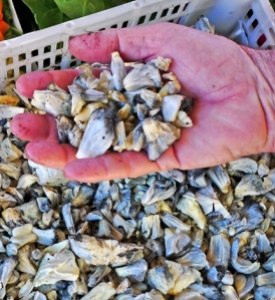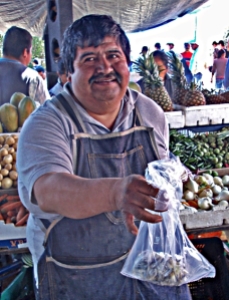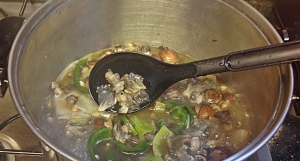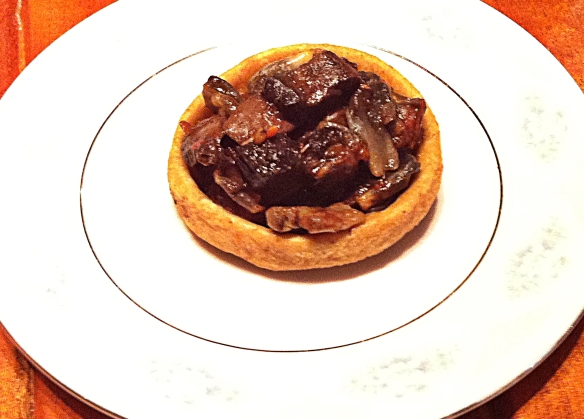Don Day thinks it’s definitely time to give the Mexican truffle its place in the sun.
Mexican truffle? You’ve never heard of it? Well, neither had Don Day until about ten years ago. Mexican truffle is one of the names it’s known by. To North American corn growers who are afraid of it infecting their plants, it’s mostly known as smut. And to Mexicans, who appreciate it’s delightful flavor, it’s a delicacy known as huitlacoche.
Now Don Day has always enjoyed smut. Especially in those formative, boys will be boys, adolescent years. I remember I would dream of the day I’d be able to leave home and could get a subscription to Modern Sunbathing and Hygiene. And be able to leave it on the bedside table instead of under the mattress. And never have to rehearse the because I love volleyball excuse to explain it to my parents.
Because I’ve always enjoyed smut, Don Day should have known he would be very fond of huitlacoche.
Huitlacoche, pronounced weet-lah-koh-chay, is not really a truffle, though, like the truffle, it is a member of the fungus family. It infects corn plants and replaces the kernels with distorted tumors that make the cobs look like creatures from low budget fifties sci-fi flicks. After a little pruning and primping, with their abstract shapes and black, brown, grey and white colors, huitlacoche definitely resembles our most familiar fungus, mushrooms. The taste is a little like a mild version of European truffles. Let’s say it’s like a woodsy, earthy, nutty, smoky mushroom.
Like many words that have entered Mexican Spanish, huitlacoche derives from Nahuatl, the language of the Aztecs. There are a few possible origins of the word in Nahuatl but Don Day’s favorite is definitely raven’s excrement. And you thought the words corn smut were a turn-off!
In San Miguel de Allende, you can buy fresh huitlacoche at Mercado San Juan de Dios, at Mercado Ignacio Ramirez, at many of the fruit and veg tiendas around town or occasionally (including this week), at Mega or Soriano, Mexico’s bow to north of the border supermarket shopping. I bought mine this week at San Miguel’s Tuesday Market. Don Day’s huitlacoche came from one of my favorite little stalls located close to the far east end of the market after you’ve passed most of the food stalls. That’s the owner of the stand in the photo, the guy with a smile a mile wide, handing me my 10 peso bag. I would compare huitlacoche favorably with chanterelles, morels, cepes or any of the other of the world’s most precious mushrooms, so a decent size bag for less than a buck is one of the world’s culinary bargains.
So now, how to prepare huitlacoche? In Mexico, it’s most often found in quesadillas or one of the many other forms of stuffed tortillas that are served in this country but then so many things are most often found on or between tortillas in Mexico. I think the uses of huitlacoche are almost endless and my recommendation is to start by treating them as a mushroom. When you make a mushroom omelette, replace the mushrooms with huitlacoche. When you put sauteed mushrooms on your steak, replace them with huitlacoche. For lunch today, I had huitlacoche sprinkled over a green salad in the same way you’d use raw mushrooms.
Don Day’s Wife combines huitlacoche with fresh creminis and poblano peppers to make a wonderful soup which I’ve asked her to share the recipe for. You’ll recognize her handwriting because it’s much bolder than Don Day’s.
Huitlacoche Poblano Soup (serves 6)
1 large leek, washed and chopped
1 tbsp. olive oil
225 grams (1/2 pound) huitlacoche
225 grams (1/2 pound) cremini mushrooms, chopped (you can substitute with white)
2-3 poblano peppers, cleaned and chopped with seeds and veins removed (the quantity depends on how much heat you want – I use three unless I’ve got some spice sensitive guests)
5 cups chicken stock
1/2 cup heavy cream
1/2 tsp. fresh ground pepper
1/2 tsp. fresh grated nutmeg
Sweat the leeks in the olive oil over low heat (put olive oil and chopped leeks in pan, cover with a layer of parchment paper or tin foil, then with the pot lid). You want the leeks to become tender, but not brown.
Add the huitlacoche and the creminis. Saute until tender. Add chicken stock and poblano peppers. Cook over medium heat until peppers are tender.
Puree with immersion blender (or cool and blend in blender in batches) until smooth.
Add heavy cream and reheat. Salt to taste.
Serve with a dollop of sour cream (crema aciete) and a grate of fresh nutmeg.
Not that Don Day gives a tinker’s damn about much other than how something tastes, I do know that other people do. As far as nutritional value is concerned, huitlacoche has most of the same good things that corn has plus one very large extra. Huitlacoche contains lycine, one of those essential amino acids (don’t ask me tricky questions like why they’re essential). I do know that lycine is like candy to bodybuilders and, just once in my life, I would like someone to use the word buff in the same sentence as Don Day.
If you’d like to try huitlacoche in a San Miguel restaurant, the recently opened Las Quatro Milpas occasionally has a wonderful sope topped with huitlacoche, portabello and epazote.
For the two or perhaps three readers Don Day might have outside of Mexico, I’m not sure I’ve ever seen fresh huitlacoche for sale but you can find it in restaurants; it’s on the menu at Tu y Yo in Boston and at La Casita Mexicana in Bell, outside Los Angeles. You can buy it in a can in Kensington Market in Toronto but after first trying tinned huitlacoche (“How could anything this good become so bad just because somebody put it in a can.”), Don Day’s Wife refused to ever eat the canned variety again, so forget that. Don Day believes it’s the slimy texture (imagine a can of garden slugs) that’s a by-product of the canning process, that causes it to be so maligned. To Don Day, who’s often been served the canned variety in restaurants, it tastes just as good.
Like Don Day, you may just have to get on a plane to get your fresh smut. And in San Miguel de Allende, there’s always fabulous fungus among us.









Rinsing the canned huitlacochoe before using it can make a huge difference.
LA Capilla behind the Parroquia used to have the most amazing crepes with huitlacoche. When I brought tours to Mexico I would take them there. Then when they were ooohing and aahing wanting to know what it was – THEN I would tell them. By then they already loved it and didn’t care. Nirvana has a fabulous soup with squash blossoms on one side of the bowl and huitlacoche on the other. A wonderful marrying of flavors. I LOVE the season of fresh huitlacoche. Yum.